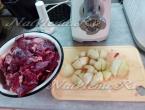What's the best way to make a stir-fry for soup? Fried carrots with onions. Delicious gravy. Recipe with photo. What vegetables and roots to use for frying
Roasting is overcooked vegetables for soup. Frying is used to put lightly fried vegetables into the soup rather than raw ones. Because many people don’t like boiled onions or carrots. At the same time, the taste qualities of vegetables not only do not deteriorate, but are also enhanced.
How to prepare roasted carrots and onions for soups
Carrots are grated. Large or small depends only on your taste. For soups, I grate carrots on a coarse grater. Cut the onion the way you like. Large or small does not matter. I don't cut the onion very finely myself. I cut the medium onion in half, then in half again to make quarters. And only then across it in thin stripes.
What to fry with?
The question is controversial. Some people like to fry in ghee, some in butter, some in vegetable oil. I prefer to fry soup in vegetable oil. I don’t know why - I’m used to it, and my mother does the same.
To begin with, one carrot is fried over low heat. To save time, I first peel it, grate it and set it to fry, and while it’s frying, I get to work on the onions. Just by the time the onion is peeled and chopped, I add it to the carrots. Those. The carrots are fried over medium heat for several minutes. Then about the same amount with onions.
If you put all the carrots and onions together in a frying pan at once, the onions will fry faster, but the carrots will still be raw, and you will end up with either burnt onions or undercooked carrots.
After the onion has acquired a golden color and has become soft, we send it all to the pan in which the soup is boiled. Everything is very simple, as you can see!
An acquaintance, I remember lamenting: Well, why, why is your pea soup beautiful, and Valya’s is gray-green? Because I don’t spare carrots, and I sauté them correctly.
How is this correct? For soup - an important point - the carrots are sautéed until they color the oil. So you need to keep the heat on medium and stir it, not letting it burn or dry out, or let it simmer a little - there’s literally one extra minute and the juice from the carrots is released into the oil. I understand that this sounds strange and unprofessional - but that’s exactly how it is.
I also never boil spices or bay leaves in soup. First - just salt. Well, maybe ground black pepper. I would completely remove peppercorns from canteens. I would forbid it.
Sometimes you eat soup, and then you scoop up a spoonful of these peas from the bottom...ugh. I wish I had visited!
I also sauté vegetables in the same pan, but one at a time. For example, first the onions and carrots, as soon as they are sautéed, I move them to the edges and chop the garlic in the middle. I fry the garlic for a minute, stir everything together and pull it apart again, freeing the middle - I put the lettuce pepper there.
A minute or two on the pepper - I mix everything again. Something like that.
I remove the finished soup from the stove and only then add a bay leaf to it - I just stick it in, herbs (fresh or dry) and other spices (others, however, rarely). Cover with a lid and leave for about 15 minutes. Only then stir and you can eat. I’m not boiling, as I said above.
If you are used to cooking with spices, try doing it as I advise once and “feel the difference” (c)
For cold days, there is a recipe for pea soup. No potatoes. You can cook it without meat at all. Or you can fry bacon or smoked sausages separately and add them along with the sauté.
A few more words about soups
I explained there a little vaguely about sautéing carrots.
I'll explain in a little more detail.
Carrots should be simmered with oil over medium or slightly less than medium heat (depending on the thickness of the pan). The thinner the pan, the lower the fire.
You have carrots over high heat, and all other vegetables are fried almost dry, rather than sautéed.
Sautéed vegetables should not have fried crusts. They are simmered in a small amount of oil. And you need to simmer them carefully. Vegetables should release their color into the oil. That is, color the oil. With onions this is not very noticeable, but carrots, lettuce peppers, beets color the oil.
A common mistake is either quickly overcooked vegetables. Or, on the contrary, undercooked. Sometimes it already seems to you that the same carrots are ready, but in fact you should wait a couple more minutes, carefully monitor and stir - and bam! - the oil becomes colored.
This is what perfectly sautéed carrots look like. Do you see what color the oil is? What color are the carrots themselves?
Another common mistake is saving on sauteing. Here the principle is “Jews, don’t skimp on the tea leaves.” Now you cook it in the usual way - try next time adding more vegetables per onion and one carrot - you will immediately understand HOW much the taste changes.
And here’s another mistake - overcooking. That is, you, having forgotten your school physics course, first boil the potatoes until tender, then add the rest of the vegetables and cook, cook, cook. And then you remove the pan from the stove, and the larger the pan, the longer the heat is retained, that is, the process of cooking the same vegetables, the same potatoes, continues. And the end result is an unintelligible porridge, not a soup.
I check potatoes like this:
While it’s still in its entire shape, but it’s been boiling for about five minutes, I take out a piece and press it with the blunt side of a knife - if it easily breaks into two parts, that’s it. I quickly add the sauté and noodles, bring it to a boil again and immediately remove it. (Or I carefully tip it onto a nearby table - if it is a 50-liter stainless steel pan with pickle, as I just did).
That's why my soups are always delicious. It doesn't matter if I'm brewing five or two hundred servings.
The other day Belka and Den came by. For ideological reasons, they refused to eat restaurant borscht, and they happily ate the pea soup that I prepared for tourists for lunch and called it ideal. (Bragging, yes!).
Let me clarify right away - the one with potatoes is called home-style meat solyanka. The one without potatoes is a meat solyanka (classic recipe). And homemade was already born in the Soviet years: more potatoes, less smoked meats.
depositphotos
How to prepare frying for soup
The main rule is, of course, to prepare the dish with love. And in a good mood. The second rule: you need to select only high-quality vegetables. For classic frying, you will need carrots (fresh and juicy) and onions (white, not colored). So, how to prepare a roast?
To begin, grate the carrots. Small or large - it's up to you. It all depends on your taste. The onion must be chopped fairly finely. To do this, take a medium onion, cut it in half, then cut it in half again. You should end up with quarters. And only then you can carefully cut the onion crosswise into thin strips and squares. By the way, to prevent the onion from stinging your eyes, periodically wet it with cold water while slicing.
What to fry the roast on?
This issue is highly controversial. After all, some people like to cook with ghee, some with vegetable oil, and some with butter. And yet, experienced chefs advise using vegetable oil to prepare frying soup. After all, there will be enough animal fats (subject to the preparation of meat broth) in the soup.
How to fry? First, fry the grated carrots over low heat. At this time, you can start chopping onions. Carrots should be fried over medium heat for a couple of minutes. Add onion and cook until golden brown.
Vegetable frying
Modern housewives often add, in addition to onions and carrots, some vegetables to the frying. Next we present the original recipe for roasted vegetables.
You will need: 500 g of tomatoes, 2 bell peppers, 1 onion and oil for frying.
First, cut the skin of the tomatoes crosswise. Pour boiling water over them for literally a minute and hold for 10 seconds under cold water. This way the skin will come off easily. Cut the tomatoes into cubes.
Finely chop the onion and fry in vegetable oil for a couple of minutes. Next add the tomatoes.
A recipe for frying soup for the winter can be an excellent lifesaver for working women who do not have much time to prepare lunch or dinner for the whole family. Having such preparation, preparing aromatic soup in 20 minutes is not difficult. Well, the fact that during the harvest season vegetables are much cheaper than in winter, and the quality of vegetables leaves much to be desired, also plays an important role.
I prepare a completely simple fry, you can add other ingredients, I prefer to use onions, carrots, bell peppers and a little tomato. Sometimes I don’t even add tomatoes.
IMPORTANT: it is advisable to cook all the frying ingredients in separate pans and then simmer together, since the cooking time for each vegetable is different.
Wash the carrots, peel them and grate them on a coarse grater.

Peel the bell pepper from seeds and cut into cubes.

I'll cook the carrots and bell peppers in the same pan because the peppers will release their juices and allow the carrots to cook a little. Pour 2 tbsp into the pan. vegetable oil, put the frying pan on the fire. Fry the carrots for 5-7 minutes, then add the bell pepper and fry the vegetables, stirring, over medium heat for another 10 minutes. Make sure that the vegetables do not burn.

Cut the onion into small cubes.

Fry the onion for 5-7 minutes with the remaining 1 tbsp. vegetable oil until soft, it is important not to let the onions burn, otherwise the frying will be bitter!

Place fried carrots and bell peppers in a frying pan with fried onions.
If you want to cook the roast without tomatoes, then simply simmer the vegetables for another 10 minutes until the liquid evaporates.

I'm preparing a roast with tomatoes. Cut the tomatoes into very small cubes.

Add the tomatoes to the rest of the vegetables and simmer for another 15-20 minutes.

There should be no liquid left in the frying; pieces of vegetables will simply be coated in vegetable oil.

The roast for the soup for the winter is ready. We distribute the finished frying into small jars, pre-sterilized. Let the frying cool completely in the jars and store the workpiece in a cool place.

Delicious and aromatic soups with a wonderful preparation!!!




